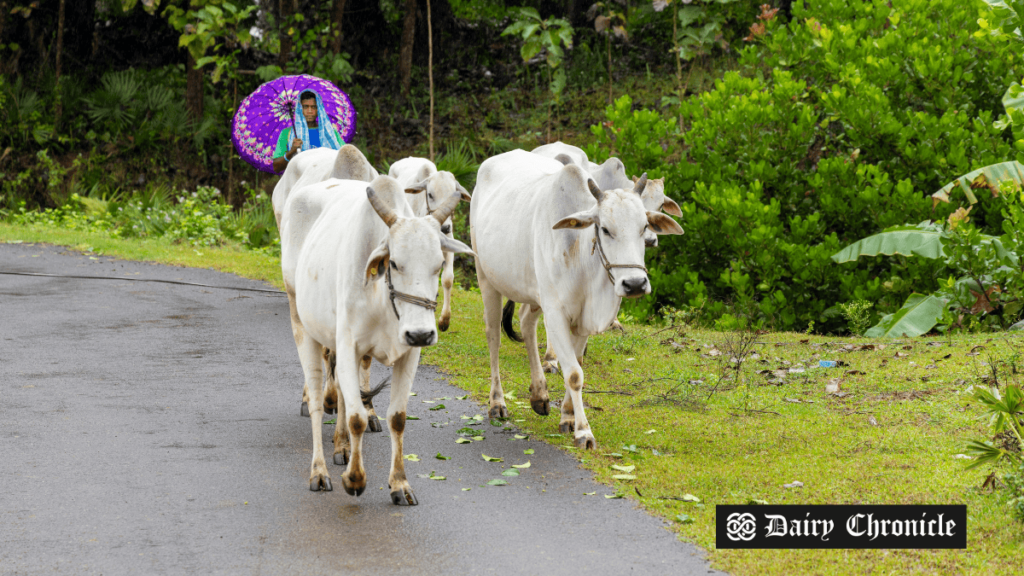India is conducting its 21st Livestock Census to assess the population of 16 species across the country. The survey, launched by the Ministry of Fisheries, Animal Husbandry, and Dairying, aims to gather data for policy development on breed improvement, disease control, and financial assistance for farmers. The census, with a budget of $50 million, employs 100,000 enumerators using digital tools. It also tracks women’s participation in livestock farming, stray animal populations, and shifting livestock patterns. Farmers hope the data will lead to better infrastructure and support for the dairy industry.
The Indian Ministry of Fisheries, Animal Husbandry, and Dairying has launched the 21st Livestock Census, a large-scale survey to assess the nation’s livestock population. The census, which began in October 2024, aims to collect comprehensive data on 16 species, including cattle, buffaloes, sheep, goats, horses, donkeys, camels, pigs, dogs, chickens, ducks, geese, and yaks, covering a total of 219 breeds. The findings are expected to be released by July 2025.
In Haryana’s Faridabad district, farmers like Vijender and Narender, both in their 60s and residents of Kanware village, hope the census will lead to increased support for dairy farming in their locality. Currently, they must travel daily to Faridabad to sell milk due to the absence of a local dairy or milk collection center. “If the government sees the number of milking animals, they might set up a dairy here,” said Narender, who owns two cows and a buffalo.
The census has a budget of ₹419 crore ($50 million) and employs approximately 100,000 enumerators and 17,000 supervisors across India. Enumerators like Sundar Lal, 50, are visiting rural and urban households to collect livestock data. The government expects the census results to shape future policies, including breed improvement, disease control, and financial assistance for farmers. Union Minister Rajiv Ranjan Singh emphasized the importance of the initiative, noting that livestock farming is a major source of employment, income, and nutrition for millions of Indian households.
Data Collection Process and Emerging Trends
Enumerators are using a specialized Android-based mobile application to record livestock details, including breed, age, and unique identification numbers. The app also allows enumerators to upload images and verify data. Dipak Kumar, an enumerator in Faridabad, explained that animals are tagged with metal identifiers, and data on milch and non-milch animals, calves, and cattle shed facilities are meticulously documented.
The census is also tracking stray animals for the second time. In Faridabad, stray dogs account for 8% of the human population, and stray cattle continue to be a challenge for farmers. Haryana has 11 registered gaushalas (cow shelters) receiving government subsidies, in addition to numerous unregistered private shelters. Dr. Virender Sehrawat, Deputy Director of Animal Husbandry, Faridabad, confirmed that all cattle in registered shelters are being tagged for proper documentation.
Jagat Hazarika, an advisor with the Union Ministry of Animal Husbandry, stated that for the first time, the census will provide data on women engaged in livestock farming. Preliminary estimates suggest that over 70% of livestock rearers are women. Dr. Monika Singh, a veterinary surgeon supervising the census, is overseeing the quality of data collected and ensuring that enumerators adhere to guidelines for identifying livestock breeds.
Women Leading Dairy Initiatives
Women entrepreneurs are playing a significant role in the dairy industry. Poonam Chaudhary, 29, and her sister Neelam Chaudhary, 27, run Poonam Dairy in Ballabgarh, Faridabad. They have expanded their farm from one buffalo to 12 buffaloes over the past nine years and now aim to set up a cow dung gas plant. “The demand for quality milk is growing, and we hope this census will push the government to provide more healthcare and financial assistance for livestock farmers,” Poonam said.
Similarly, Milan Sharma, 56, a former project manager for a German government educational initiative, turned to livestock farming in 2018 after inheriting her father-in-law’s indigenous cows. Her farm once had over 250 cows, but she has since donated many to villagers and now maintains around 100 cows. Milan integrates agriculture with dairy farming using organic practices, producing cereals and oilseeds using cow dung fertilizers. She also conducts training programs for farmers across Haryana.
Shifting Livestock Patterns
Initial trends from the census indicate potential changes in livestock numbers. The 20th Livestock Census revealed declining populations in several species, including a 37.1% drop in camels, 12% in pigs, and 61.2% in donkeys. However, poultry numbers increased by 16.08%. Officials anticipate higher livestock figures this time due to post-pandemic investments in farming, despite setbacks like the 2022 lumpy skin disease outbreak, which caused significant cattle losses.
In Haryana, preliminary findings suggest a rise in cow numbers but a possible decline in buffaloes within households, though buffalo farming is increasing in commercial farms. The Haryana Gauvansh Sanrakshan and Gausamvardhan Act, 2015, which restricts cattle trade and slaughter, may have contributed to these trends.
Dr. Sehrawat noted an increase in pet dogs, mostly exotic breeds, in Haryana households. However, the census process faces challenges, including technical issues with the app, which frequently logs out and requires a strong internet connection. Enumerators often have to upload data at offices or home using WiFi.
As the 21st Livestock Census progresses, its data is expected to play a crucial role in shaping policies for livestock development, disease management, and rural employment. Farmers like Vijender and Narender remain hopeful that the survey will bring better infrastructure, increased subsidies, and improved healthcare for livestock. With the census covering millions of households, it is set to provide vital insights into India’s changing livestock landscape, influencing government decisions for years to come.
